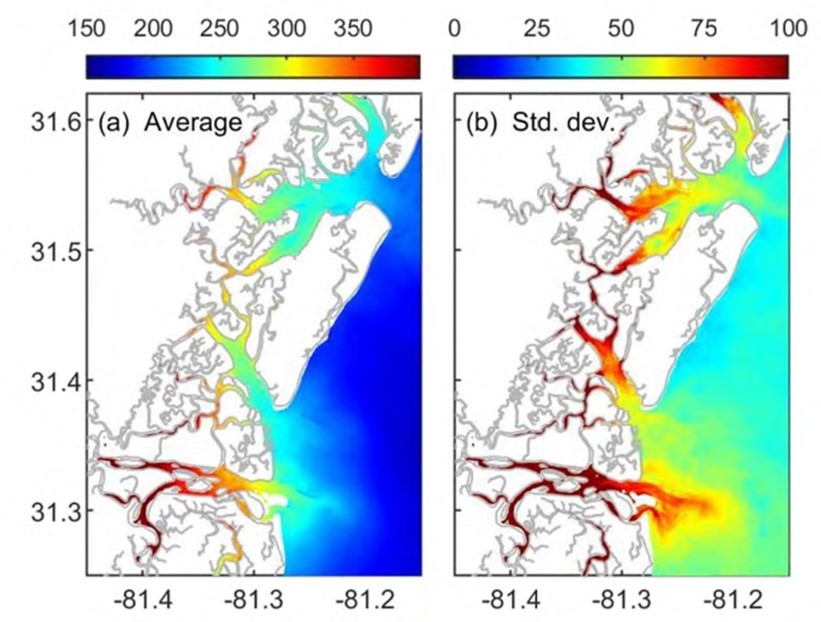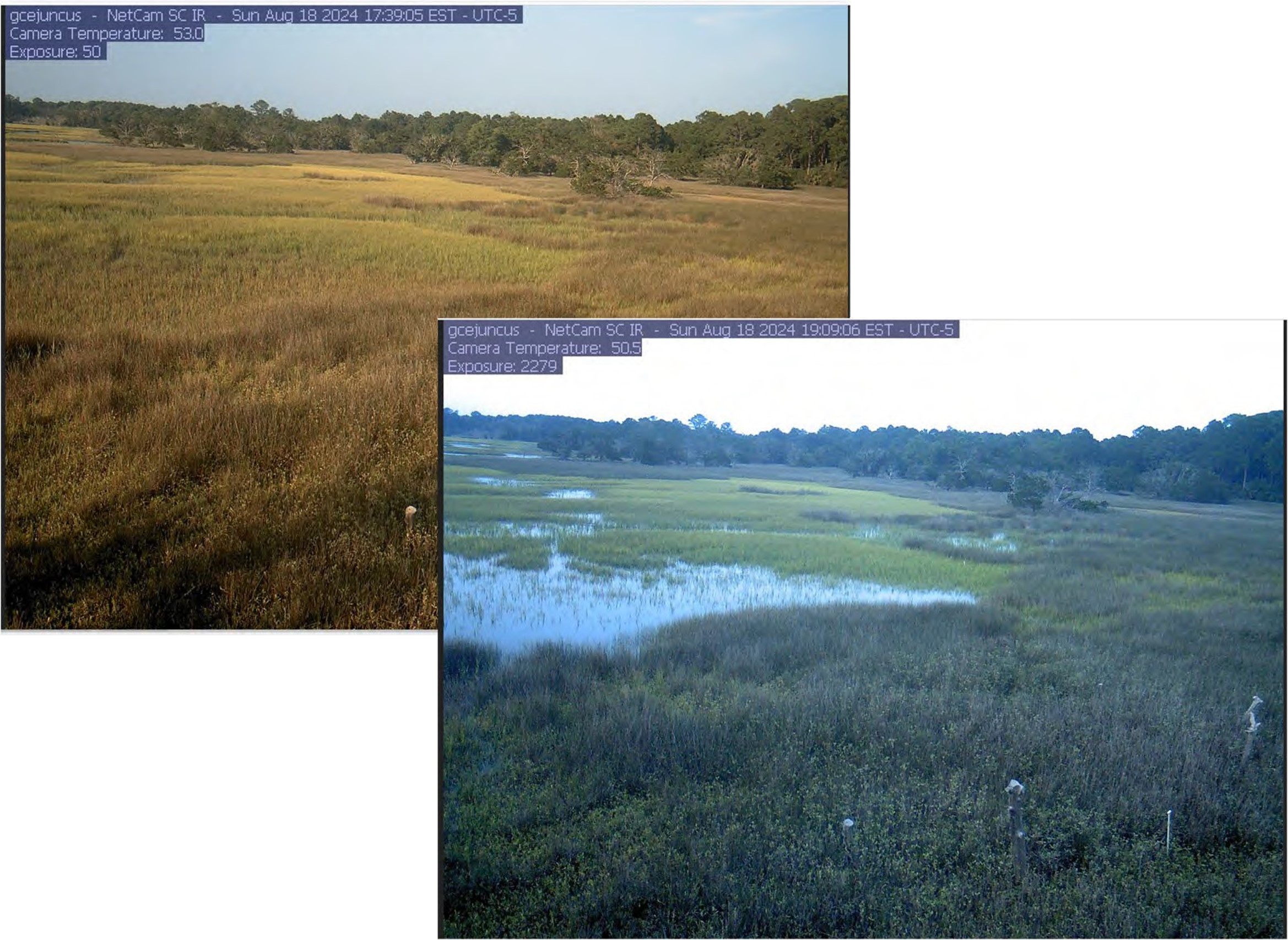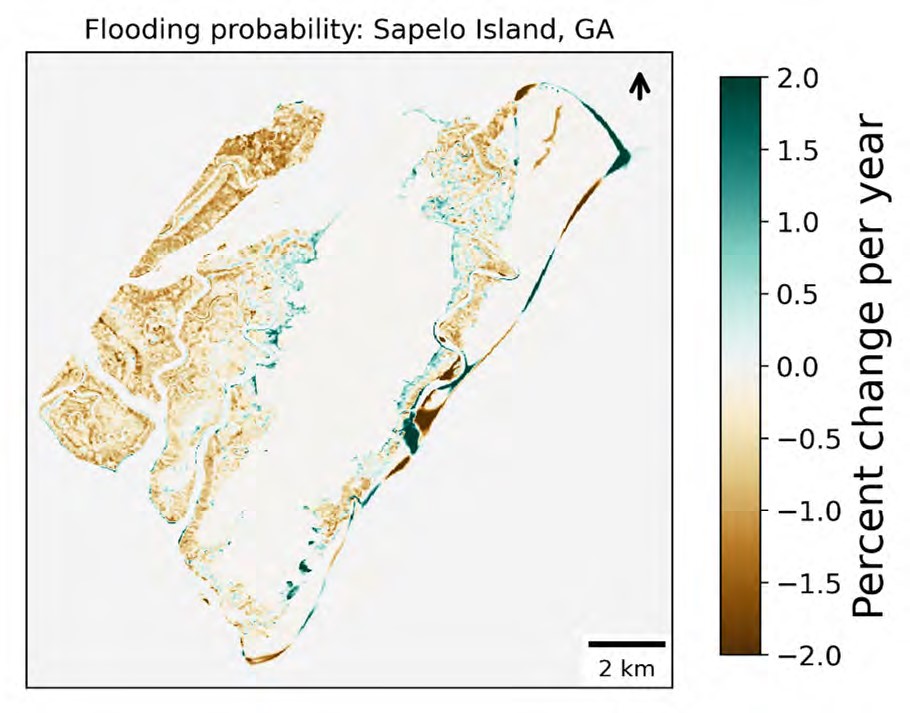Area 2: Long-term Patterns of Estuary and Intertidal Variation
|
|||||
|---|---|---|---|---|---|
Long-term Patterns of Estuary and Intertidal VariationWe track the temporal and spatial variability of the habitats within the GCE study area through a combination of field monitoring and remote sensing in order to evaluate ecosystem responses to long-term change and domain perturbations. The field monitoring program includes regular sampling in both the water column and intertidal habitat at a series of 11 core long-term monitoring sites that range across the domain (Fig. 1). Research ObjectivesA) Field Monitoring
B) Remote Sensing
|
|||||
Current Progress ReportBelow is an update for each of the Area 2 objectives as reported in the most recent annual report. For a list of all reports click here (Annual Reports). A) Field Monitoring

Table 1. Monitoring program for GCE-IV. LTER core areas are 1: primary production, 2: populations, 3: organic matter cycling, 4: inorganic nutrients, 5: disturbance.

Fig. 2. Long-term (2013-2023) a) average and b) standard deviation of DOC concentration (µmol L-1) in the GCE domain estimated from Landsat observations. Source: Castelao and Medeiros 2024.
B) Remote Sensing

Fig. 3. Field of view of the GCEJuncus PhenoCam on 8/18/2024, showing the marsh exposed @17:39h (top) and flooded @19:09h (bottom).
|
|||||
Area 2 Publications from GCE-IVRobinson, M., Alexander, C.R. Jr. and Venherm, C. 2022. Shallow Water Estuarine Mapping in High-Tide-Range Environments: A Case Study from Georgia, USA. Special Issue: Shallow Water Mapping. Estuaries and Coasts. 45:980-999. (DOI: https://doi.org/10.1007/s12237-021-01032-y) Liu, W. and Pennings, S.C. 2019. Self-thinning and size-dependent flowering of the grass Spartina alterniflora across space and time. Functional Ecology. 33:1830-1841. (DOI: 10.1111/1365-2435.13384) Meile, C. 2023. Presentation: Carbon fluxes and environmental drivers in an intertidal marsh. , April 27, Chungham National University, Dajeon, South Korea. Schalles, J.F., Hladik, C.M., O'Donnell, J., Miklesh, D.M., Pudil, T. and Nealy, N. 2021. Presentation: Satellite and drone remote sensing to study decadal scale and high resolution spatial-temporal patterns and declines of Spartina alterniflora above-ground biomass in Georgia, USA salt marshes. Session 2. 1st International Symposium on Coastal Ecosystems and Global Change (CoEco1), April 18, 2021, Xiamen University, Xiamen, China. Schalles, J.F., Hladik, C.M., O'Donnell, J., Miklesh, D.M., Pudil, T., Nealy, N. and Currin, H. 2021. Presentation: Serious multidecadal declines in aboveground biomass of the keystone salt marsh species, Spartina alterniflora, are related to climate change in coastal Georgia, USA. Wetlandscapes: Understanding the Large-scale Wetland Functions in the Landscape Symposium. 11th INTECOL International Wetlands Conference, October 14, 2021, Christchurch, New Zealand (virtual, prerecorded). O'Connell, J.L., Alber, M., Mishra, D. and Byrd, K. 2020. Presentation: Structural heterogeneity in above vs belowground biomass pools differ for Spartina alterniflora monocultures, with consequences for forecasting ecosystem resiliency. Ecological Society of America. Area 2 Publications from GCE-IIIJournal ArticlesLiu, W. and Pennings, S.C. 2019. Self-thinning and size-dependent flowering of the grass Spartina alterniflora across space and time. Functional Ecology. 33:1830-1841. (DOI: 10.1111/1365-2435.13384) Peterson, R.N., Meile, C., Peterson, L., Carter, M. and Miklesh, D.M. 2019. Groundwater discharge dynamics into a salt marsh tidal river. Estuarine, Coastal and Shelf Science. 218:324-333. (DOI: 10.1016/j.ecss.2019.01.007) Damashek, J., Tolar, B., Liu, Q., Okotie-Oyekan, A., Wallsgrove, N.J., Popp, B.N. and Hollibaugh, J.T. 2018. Microbial oxidation of nitrogen supplied as selected organic nitrogen compounds in the South Atlantic Bight. Limnology and Oceanography. 64:982-995. (DOI: 10.1002/lno.11089) Li, S., Hopkinson, C.S., Schubauer-Berigan, J.P. and Pennings, S.C. 2018. Climate drivers of Zizaniopsis miliacea biomass in a Georgia, U.S.A. tidal fresh marsh. Limnology and Oceanography. 63:2266-2276. (DOI: 10.1002/lno.10937) Liu, Q., Tolar, B., Ross, M., Cheek, J., Sweeney, C., Wallsgrove, N.J., Popp, B.N. and Hollibaugh, J.T. 2018. Light and temperature control the seasonal distribution of Thaumarchaeota in the South Atlantic Bight. ISME Journal. 12:1473-1485. (DOI: 10.1038/s41396-018-0066-4) Conference Papers (Peer Reviewed)Conference Posters and PresentationsCraft, C.B., Stahl, M. and Widney, S. 2017. Presentation: Tidal freshwater forests: sentinels for climate change. 10th International Workshop on Nutrient Cycling and Retention in Natural and Constructed Wetlands, September 21-24, Trebon, Czech Republic. Peterson, R.N., Meile, C., Carter, M., Peterson, L., Waldorf, A. and Miklesh, D.M. 2017. Poster: Groundwater inputs to a back-barrier salt marsh tidal river. 2017 Chemical Oceanography Gordon Research Conference, July 2017, Holderness, NH. Stahl, M., Widney, S. and Craft, C.B. 2017. Presentation: Tidal freshwater forests: a sentinel for climate change. SPEA Ph.D. Students' 17th Annual Conference, February 24, 2017, Bloomington, IN. Widney, S., Stahl, M. and Craft, C.B. 2017. Presentation: Tidal forests: sentinels for climate change. Society of Wetland Scientists Annual Meeting, June 8, 2017, San Juan, Puerto Rico. Hollibaugh, J.T., Liu, Q., Ross, M., Cheek, J., Sweeney, C., Tolar, B., Hagan, P., Whitby, H., Bratcher, A., Malagon, E., Lynn-Bell, N., Shalack, J., Reddy, C.M. and Walker, J.T. 2016. Poster: Coupling between Sediment and Water Column Populations of Ammonia Oxidizing Thaumarchaeota in a Salt Marsh Estuary. Alber, M., Schaefer, S.C., Pomeroy, L.R., Sheldon, J.E. and Joye, S.B. 2008. Presentation: Nitrogen inputs to the Altamaha River estuary (Georgia, USA): a historic analysis. American Society of Limnology and Oceanography, 3/08, Orlando, FL. Alber, M., Schaefer, S.C., Pomeroy, L.R., Sheldon, J.E. and Joye, S.B. 2008. Presentation: Nitrogen inputs to the Altamaha River estuary (Georgia, USA): a historic analysis. American Society of Limnology and Oceanography, 3/08, Orlando, FL. Seay, J.E., Bishop, T.D. and Tilburg, C.E. 2006. Poster: Spatial and temporal variations of Porcelain Crab larval abundance in a Georgia Estuary. Southeastern Estuarine Research Society Fall 2006 Meeting, 19 October - 21 October 2006, Savannah, Georgia. Pennings, S.C. 2005. Presentation: Physical forcing and variation in salt marsh plant productivity at multiple time scales. Ecological Society of America 2005 Meeting - Ecology at multiple scales, August 7-12, 2005, Montreal, Canada. Bishop, T.D. 2003. Presentation: Invasive biology and status of the green porcelain crab (Petrolisthes armatus) in Georgia waters. South Georgia Invasive Species Workshop, sponsored by The Nature Conservancy and Sapelo Island National Estuarine Research Reserve. October 2003, Brunswick, GA. Bishop, T.D. and Hurley, D. 2003. Poster: The non-indigenous porcelain crab, Petrolisthes armatus: population trends in the Sapelo Island National Estuarine Research Reserve. 2003 Estuarine Research Federation meeting. September 2003, Seattle, WA. Bishop, T.D. and Hurley, D. 2003. Poster: The non-indigenous porcelain crab, Petrolisthes armatus: population trends in the Sapelo Island National Estuarine Research Reserve. National Estuarine Research Reserve System / National Estuarine Research Reserve Association Annual Meeting. October 2003, Charleston, S.C. Bishop, T.D., Hurley, D. and Alber, M. 2003. Presentation: An inventory of the macroinvertebrate fauna of oyster reefs in the Duplin River, Georgia, with emphasis on non-indigenous species occurrence. 2003 Estuarine Research Federation meeting. Sept. 14-18, 2003, Seattle, WA. Ogburn, M.B., Bishop, T.D. and Alber, M. 2003. Poster: Population dynamics of two salt marsh snails in three Georgia estuaries. Southeastern Estuarine Research Society meeting. March 2003, Atlantic Beach, NC. Bishop, T.D., Alber, M. and Wiegert, R.G. 2001. Poster: Macrofaunal population shifts and changing coastal salinity regimes. ERF 2001: An Estuarine Odyssey. Estuarine Research Federation, Nov. 4-8, 2001, St. Pete Beach, Florida. Goodbody, G., Bishop, T.D. and Alber, M. 2001. Presentation: Distribution of snails in the Satilla and Altamaha River Estuaries. Southeastern Estuarine Research Society Meeting. Southeastern Estuarine Research Society, Mar 01, 2001, Charleston, South Carolina. Pennings, S.C., Bertness, M.D., Donnelly, J.P., Ewanchuk, P.J., Silliman, B.R. and Callaway, R.M. 2001. Presentation: Impacts of global change on coastal salt marshes. Keynote address to the German Limnological Association, September 17-21, 2001, Kiel, Germany. |
|||||




